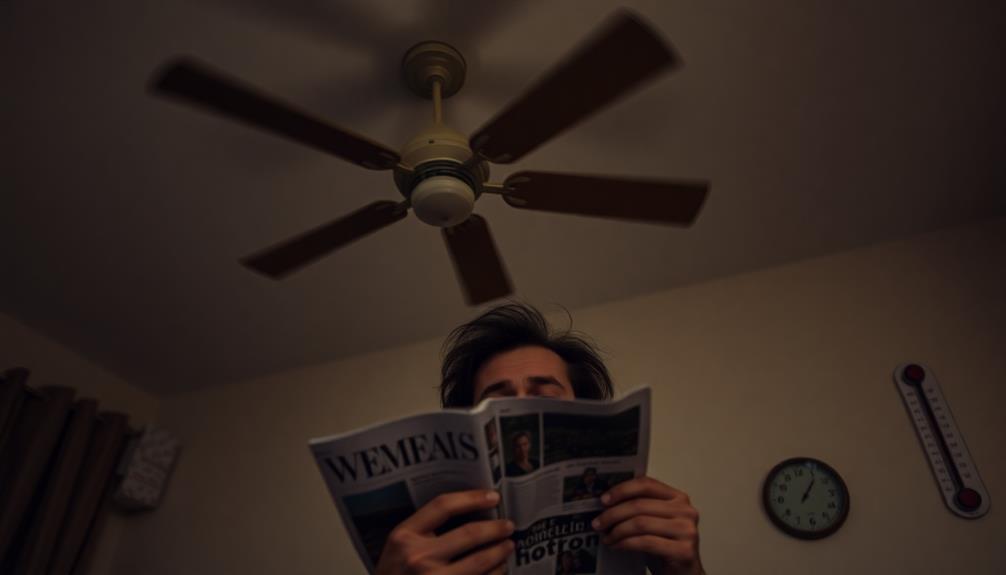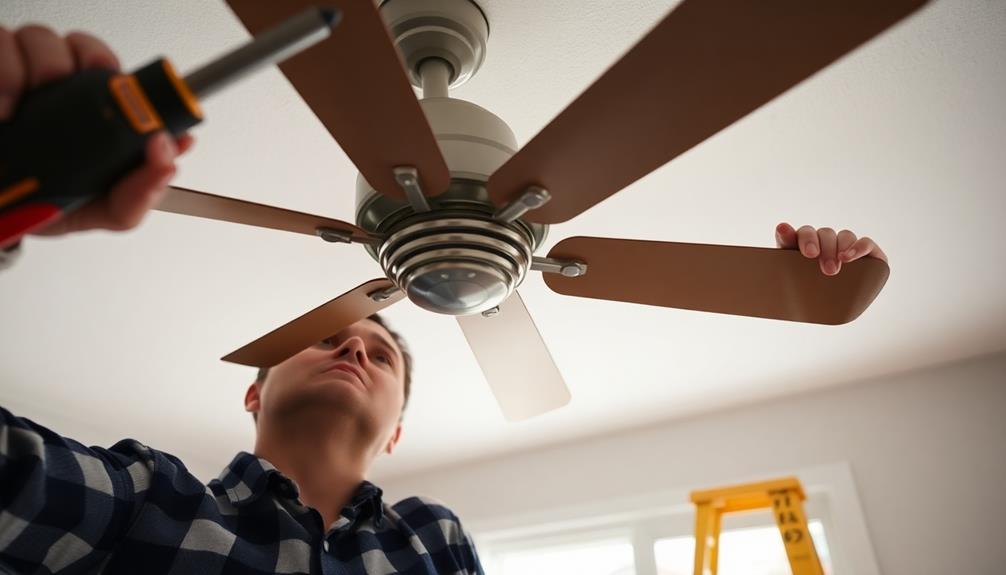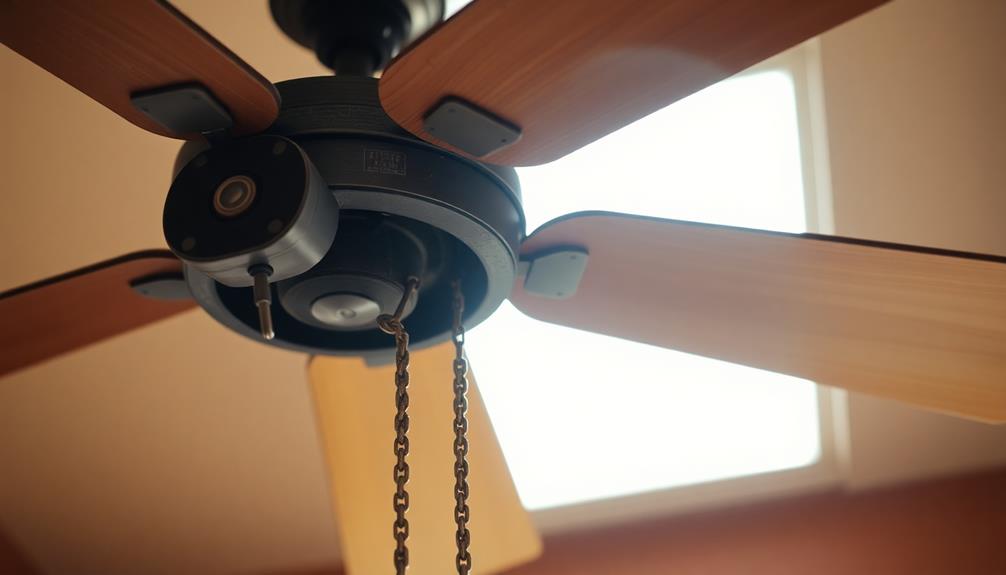If your ceiling fan is only operating at one speed, it may be caused by internal wiring issues or a defective speed control switch. To start troubleshooting, turn off the power at the circuit breaker to ensure safety. Inspect the wiring connections for any damage and use a voltage tester to confirm they are all correct. Another possible reason could be a faulty capacitor, which is responsible for regulating the fan’s speed. Neglecting this problem could result in overheating and higher electricity bills. For a more thorough step-by-step guide on how to address these issues, it is advisable to investigate the root causes and plan your next actions accordingly.
Key Takeaways
- Check for internal wiring issues that may disrupt speed adjustments and affect the fan's functionality.
- Inspect the speed control switch for faults that could limit the fan to a single speed.
- Test the capacitor with a multimeter; a faulty capacitor can prevent proper speed regulation.
- Ensure consistent power flow to the fan; irregular power can hinder air circulation efficiency.
- Seek professional help if basic troubleshooting doesn't resolve the issue or if overheating occurs.
Causes of Limited Speed Functionality

Limited speed functionality in ceiling fans often arises from a few common issues that can disrupt their performance.
You might encounter internal wiring problems that prevent the fan motor from adjusting speeds correctly. A faulty speed control switch could also leave your fan operating at just one speed, limiting your comfort.
Electrical disruptions, like inconsistent power flow, can make your fan seem stuck, affecting its ability to circulate air efficiently. If your fan is stuck on high speed, it may only operate at that speed, leaving you with little control.
Recognizing these causes can help you diagnose the issue effectively. Timely identification is essential for restoring your fan's full functionality and ensuring it meets your cooling needs.
Inspection and Troubleshooting Procedures

To guarantee your ceiling fan operates effectively, start by inspecting its wiring and components. First, turn off the power at the circuit breaker for safety.
Remove the canopy to access wiring connections, checking for any visible damage or corrosion. Secure connections are essential for proper functionality.
Use a voltage tester to confirm power is present and that your wiring is correctly connected. Conduct continuity testing to identify any breaks or faults in the wiring that may affect speed.
Also, inspect the capacitor visually and test it with a multimeter to verify it regulates fan speed properly.
If issues persist after your inspection, consider consulting a professional for a thorough diagnosis and effective repairs. They can offer specialized tools and techniques that may be difficult to replicate on your own. For example, if you need to remove smoke smell from wood, a professional can utilize deep cleaning methods and treatments designed to neutralize odors at their source. This ensures that your home is restored to a fresh, clean environment efficiently. Additionally, professionals can provide guidance on a variety of household cleaning challenges, including advice on **how to clean sofa stains**, which can sometimes be stubborn and require specialized products. Their expertise ensures that your furniture and belongings are not only clean but also well-maintained, prolonging their longevity. By addressing these issues promptly, you can prevent more significant damage and maintain a comfortable living space.
Consequences of One-Speed Operation

One-speed operation in a ceiling fan can lead to several significant consequences that undermine its effectiveness.
First, you may notice the fan running slowly or failing to start entirely, which can be frustrating. Operating at just one speed can cause the motor to overheat, increasing the risk of damage over time.
You'll also see a spike in electricity consumption, which isn't ideal for your utility bill. Additionally, limited speed options hinder your ability to control air circulation, making it harder to achieve ideal cooling comfort in your space.
Ultimately, if you ignore these issues, you could face long-term efficiency problems, reducing the fan's lifespan and performance.
Addressing these concerns promptly is essential for maintaining your ceiling fan's functionality.
Importance of Capacitor Functionality

The functionality of a ceiling fan's capacitor is essential for its overall performance and efficiency. It regulates the voltage and current flowing to the motor, allowing the fan to operate at various speeds.
When the capacitor fails, your fan might get stuck on a single speed or not start at all. This not only affects your comfort but also increases electricity consumption and puts extra strain on the motor, leading to potential overheating issues.
Regular maintenance, including checking the capacitor, can enhance energy savings & comfort by ensuring efficient operation. You might notice overheating or reduced air circulation as a result.
Regularly checking the capacitor can prevent these issues, ensuring your fan runs smoothly and efficiently. By addressing capacitor functionality early, you'll enhance the longevity and performance of your ceiling fan, keeping your space comfortable year-round.
When to Seek Professional Help

When dealing with ceiling fan speed issues, knowing when to seek professional help is crucial for your safety and the fan's longevity.
If you've checked the wiring, speed control switch, and capacitor without success, it's time to call in an expert. Signs of serious problems include persistent overheating, unusual noises, or the fan failing to operate entirely.
Don't ignore these symptoms, as they could indicate deeper electrical issues that could pose safety hazards. Additionally, if you're uncomfortable performing any inspections or troubleshooting yourself, a professional can offer peace of mind.
Remember, timely intervention prevents further damage and guarantees efficient operation, keeping your space cool and comfortable.
Don't hesitate to seek help when needed!
Frequently Asked Questions
Can I Use a Ceiling Fan With a Faulty Speed Control Switch?
You shouldn't use a ceiling fan with a faulty speed control switch. It can lead to inconsistent operation, potential overheating, and electrical hazards. It's best to address the issue promptly for safety and efficiency.
How Can I Prevent Ceiling Fan Speed Issues in the Future?
To prevent ceiling fan speed issues, regularly check wiring and connections, guarantee a clean environment, and replace faulty components promptly. Using a surge protector can also help safeguard against electrical disruptions that may affect performance.
What Tools Do I Need for Ceiling Fan Inspection?
What tools do you need for ceiling fan inspection? Grab a voltage tester, multimeter, screwdriver set, and safety goggles. These essentials help you check wiring, test the capacitor, and guarantee everything's functioning correctly.
Are There Specific Brands Known for Reliable Ceiling Fan Performance?
When choosing a ceiling fan, consider brands like Hunter, Casablanca, or Westinghouse. They’re known for reliability and performance. You’ll appreciate their durability and variety, ensuring you find one that suits your needs perfectly. Additionally, pay attention to features such as energy efficiency and noise levels, as these can greatly affect your comfort and satisfaction. If you’re interested in unique designs, explore options inspired by what Indonesians are famous for, such as intricate woodworking or vibrant colors that reflect their rich culture. This can add a touch of personalization to your space while keeping functionality in mind.
How Often Should I Perform Maintenance on My Ceiling Fan?
You should check your ceiling fan regularly, clean it often, and inspect its components yearly. Keeping it maintained guarantees peak performance, prevents issues, and extends its lifespan, so you enjoy comfortable airflow year-round.
Conclusion
To sum up, don't let a ceiling fan stuck on a single speed ruin your comfort or inflate your energy bills. By understanding the causes and following the inspection steps, you can take charge of the situation and restore your fan's functionality. Remember, addressing these issues not only improves your comfort but also extends the life of your fan. So, why settle for a stagnant breeze when you can enjoy the invigorating airflow you deserve?









